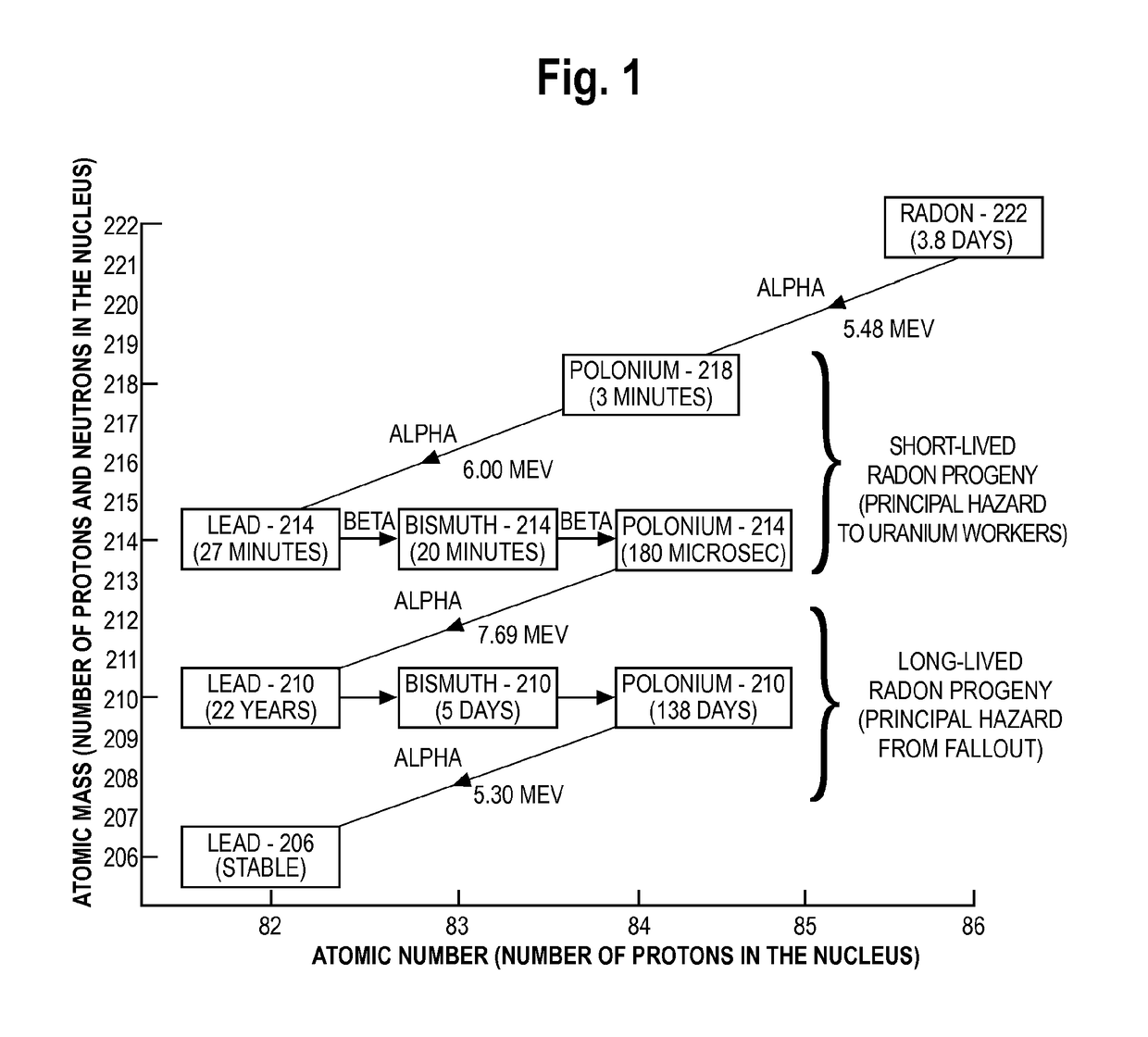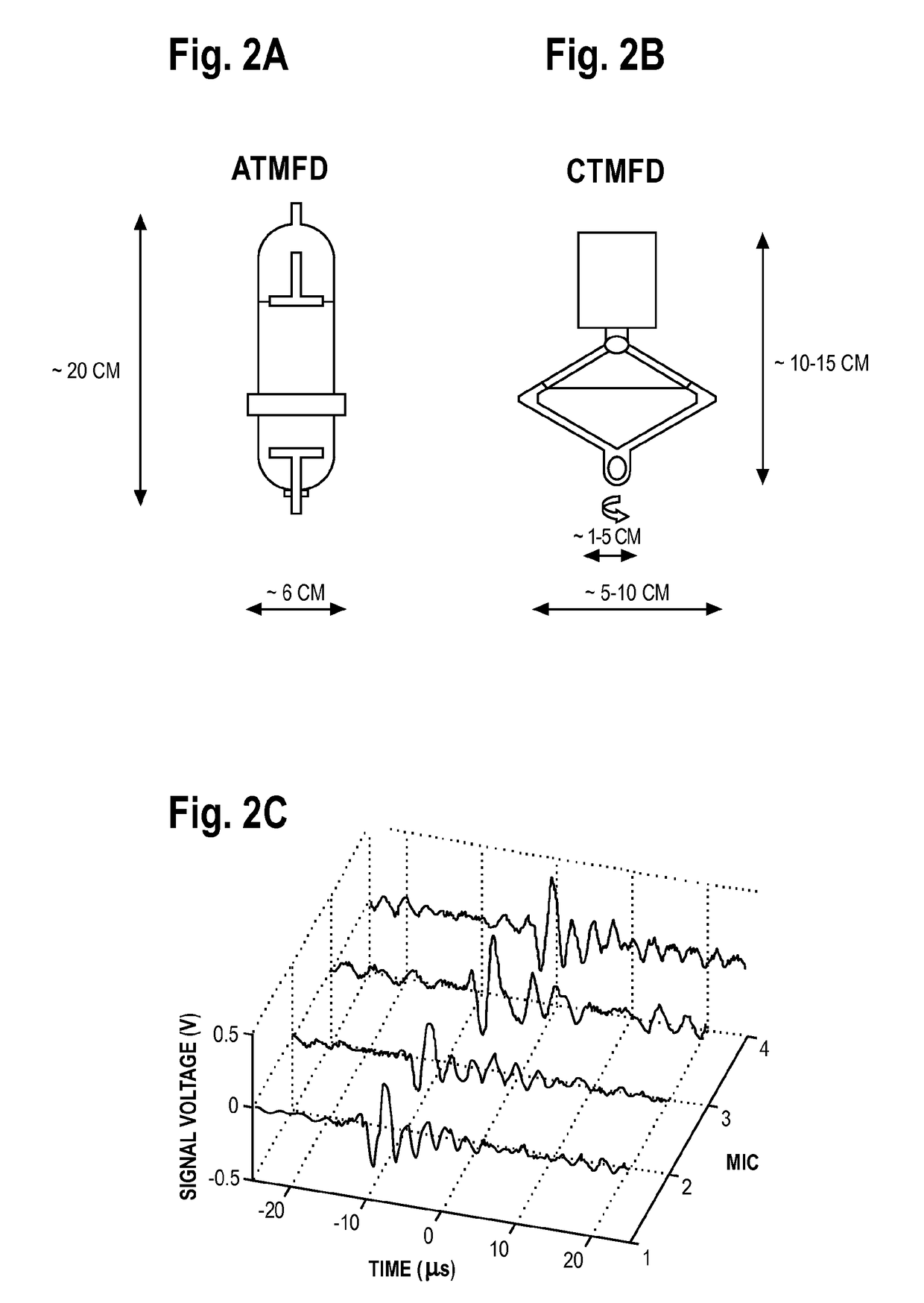Radiation detector
a detector and detector technology, applied in the field of radiation detectors, can solve the problems of 21,000 deaths annually, high cost of reliable rn monitoring systems, and society's complacentness with these deaths, and achieve the effects of reducing temperature, reducing radon retention/dissolution ability, and high affinity for radon
- Summary
- Abstract
- Description
- Claims
- Application Information
AI Technical Summary
Benefits of technology
Problems solved by technology
Method used
Image
Examples
example 1
[0058]This example demonstrates that alpha-emitting Rn in air can be efficiently collected and introduced into TMFDs. A 4-step procedure depicted graphically in FIG. 4 was used. In step 1 we used a 226Ra source (about 500 nCi) which decays to generate 222Rn gas and progeny; an airstream bubbled the material into a 100 mL acetone-filled container to generate about 10 kBq / cc in total for the stock solution as determined using our LS6500™ spectrometer. In step 2 the stock solution was diluted to about 6 Bq / mL such that when 1 mL was injected and evaporated into a 10 gal. (38.5 L) enclosed tank with a fan used for mixing, the average activity in air would amount to about 0.15 Bq / L or 4 pCi / L. In step 3 an air pump with a tube bubbled the Rn-air atmosphere at a rate of about 0.5 L / min into a 100 mL acetone-filled container over 10-minutes. In step 4 about 20 cc of the acetone was transferred into our CTMFD, as shown in FIG. 2b, to assess for activity when the tension negative pressure is...
example 2
[0061]This example demonstrates detection of Rn at EPA action limits, a process which today requires off-site monitoring. Similar steps as in Example 1 were followed starting with the formation of a stock solution and then diluting it to about 4,000 pCi / L (of Rn and progeny in water) representing the EPA maximum control limit. By bubbling air from a fish tank pump at about 1.25 L / min. for about 30 minutes and then leading the Rn-bearing air into a container with about 100 mL of hexane (an organic liquid for which the Rn-dissolution level is several times higher than for acetone) maintained at dry ice temperature. The Rn-bearing hexane was transferred into a CTMFD where, unlike for Example 1, the CTMFD central (sensitive) volume was only about 3 mL. Upon inducing centrifugal force and reaching a tension level of about −9 bar (Note: for hexane the level of tension can be about −8 bar to detect all of the Rn and alpha emitter progeny. In this example −9 bar tension was used. Reliable a...
example 3
[0062]This example demonstrates Rn detection in water (at EPA maximum allowable levels) using the disclosed TMFD without intermediate separation of Rn and bubbling as in Example 2. In this case, TMFD is filled with a mixture of 50% acetone and 50% isopentane by volume for detection of alpha radiation from Rn and progeny while in water. The Rn bearing water is directly incorporated into the TMFD fluid mixture at concentrations of about 5% followed by testing for Rn.
[0063]Radon is a gas. Its key radioactive emissions are alpha particles. Alpha particles are charged He-4 nuclei, which can be stopped with micron type layers of metal or glass or water. Detecting alpha particles of energy in the range of 5.5 MeV (for Radon-222) requires bringing Rn in direct contact with the detector internal fluid. For conventional detectors this means bringing radon directly in contact with scintillator type materials. Conventional detectors suffer from loss of efficiency since only the alpha particles ...
PUM
 Login to View More
Login to View More Abstract
Description
Claims
Application Information
 Login to View More
Login to View More - R&D
- Intellectual Property
- Life Sciences
- Materials
- Tech Scout
- Unparalleled Data Quality
- Higher Quality Content
- 60% Fewer Hallucinations
Browse by: Latest US Patents, China's latest patents, Technical Efficacy Thesaurus, Application Domain, Technology Topic, Popular Technical Reports.
© 2025 PatSnap. All rights reserved.Legal|Privacy policy|Modern Slavery Act Transparency Statement|Sitemap|About US| Contact US: help@patsnap.com



